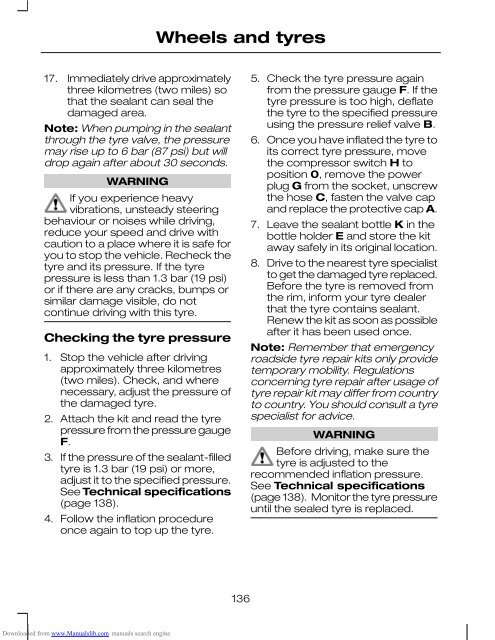fiesta
You also want an ePaper? Increase the reach of your titles
YUMPU automatically turns print PDFs into web optimized ePapers that Google loves.
Wheels and tyres<br />
17. Immediately drive approximately<br />
three kilometres (two miles) so<br />
that the sealant can seal the<br />
damaged area.<br />
Note: When pumping in the sealant<br />
through the tyre valve, the pressure<br />
may rise up to 6 bar (87 psi) but will<br />
drop again after about 30 seconds.<br />
WARNING<br />
If you experience heavy<br />
vibrations, unsteady steering<br />
behaviour or noises while driving,<br />
reduce your speed and drive with<br />
caution to a place where it is safe for<br />
you to stop the vehicle. Recheck the<br />
tyre and its pressure. If the tyre<br />
pressure is less than 1.3 bar (19 psi)<br />
or if there are any cracks, bumps or<br />
similar damage visible, do not<br />
continue driving with this tyre.<br />
Checking the tyre pressure<br />
1. Stop the vehicle after driving<br />
approximately three kilometres<br />
(two miles). Check, and where<br />
necessary, adjust the pressure of<br />
the damaged tyre.<br />
2. Attach the kit and read the tyre<br />
pressure from the pressure gauge<br />
F.<br />
3. If the pressure of the sealant-filled<br />
tyre is 1.3 bar (19 psi) or more,<br />
adjust it to the specified pressure.<br />
See Technical specifications<br />
(page 138).<br />
4. Follow the inflation procedure<br />
once again to top up the tyre.<br />
5. Check the tyre pressure again<br />
from the pressure gauge F. If the<br />
tyre pressure is too high, deflate<br />
the tyre to the specified pressure<br />
using the pressure relief valve B.<br />
6. Once you have inflated the tyre to<br />
its correct tyre pressure, move<br />
the compressor switch H to<br />
position 0, remove the power<br />
plug G from the socket, unscrew<br />
the hose C, fasten the valve cap<br />
and replace the protective cap A.<br />
7. Leave the sealant bottle K in the<br />
bottle holder E and store the kit<br />
away safely in its original location.<br />
8. Drive to the nearest tyre specialist<br />
to get the damaged tyre replaced.<br />
Before the tyre is removed from<br />
the rim, inform your tyre dealer<br />
that the tyre contains sealant.<br />
Renew the kit as soon as possible<br />
after it has been used once.<br />
Note: Remember that emergency<br />
roadside tyre repair kits only provide<br />
temporary mobility. Regulations<br />
concerning tyre repair after usage of<br />
tyre repair kit may differ from country<br />
to country. You should consult a tyre<br />
specialist for advice.<br />
WARNING<br />
Before driving, make sure the<br />
tyre is adjusted to the<br />
recommended inflation pressure.<br />
See Technical specifications<br />
(page 138). Monitor the tyre pressure<br />
until the sealed tyre is replaced.<br />
136<br />
Downloaded from www.Manualslib.com manuals search engine



